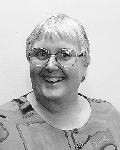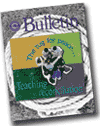 The
tug of peace: Shalom in the academy
The
tug of peace: Shalom in the academy
By Ruth Krall, director of peace, justice
and conflict studies
Tom Clancy’s most recent futurist novel, The Bear and the Dragon
(Berkeley Publishing Group of Penguin, 2000), includes a short war
involving China, Russia, NATO nations and the United States. The
fictional conflict begins when China invades Russia across their
shared border in order to “liberate” a gold mine and take
over a newly discovered source of vast petroleum resources.
In the book, former Central Intelligence Agency officer Jack Ryan
is now President of the United States. As he attempts to persuade
European allies to go to the political and military aid of Russia,
he remembers the wisdom of international diplomacy: Nations do not
have friends. They have interests.
The way to international peace for Clancy’s protagonists is
for the dominant good guys – in this case, the United States
– to wage a war with superior firepower in which human beings
are expendable collateral damage. Such a show of force is especially
needed when nation states with very different cultural understandings
have competing or opposing economic interests. Clancy’s books
provide a strong, partisan apology for the need for violence in
order to maintain world peace. Coercion, force and violence are
the peacekeepers.
Within the context of Anabaptist-Mennonite faith, such a worldview
is protested. As Christian faculty, we live within another worldview
– one which our foreparents in faith taught us. Inside the
matrix of our Christian faith, we hold that violence is never the
way to peace, never the way to resolve human conflict. We stand
as nonconformed citizens of the world and hope to express faithfulness
to the gospel of Jesus Christ by bearing witness to an alternative
understanding of peace – that of shalom.
In this view, according to Perry Yoder’s book Shalom: The Bible’s
Word for Salvation, Justice and Peace (Faith and Life Press, 1997),
to participate in God’s shalom is to engage oneself as a co-creator
with God in transformative action in the life of the world and its
peoples.
A formal peace studies curriculum began at Goshen more than 25 years
ago. Long before that time, faculty and students were individually
and communally active in searching out the meaning of peacemaking
for the 20th century. A student peace society sponsored speaking
and writing opportunities for students. Students and faculty alike
sought to understand how they should remain faithful witnesses to
the gospel of Jesus and the doctrine of peace. In 1944, Professor
Emeritus of History Guy F. Hershberger wrote his influential book,
War, Peace and Nonresistance (Herald Press, revised 1969). In addition,
faculty sought a way to find faithfulness to Jesus’ teachings
and find compassion and healing for their fellow human beings within
very troubled and troubling life situations.
Within the greater church, in the 1960s and 1970s, we saw the classical
Mennonite doctrine of nonresistance begin to stretch open to include
dialogue about nonviolence, protest activism and other emerging
forms of social protest. The language of nonviolent activism began
to be heard.
By the beginning of the new century, Goshen College had redefined
and strengthened its awareness of peacemaking as an integral part
of campus life and curricula. No longer was the organized violence
of warfare the only reality to be studied and avoided. We also examined
the domestic violence of the United States, including the violence
of our public and private schools and within networks of families
and close friends. The structural violence of poverty and issues
of environmental justice were also recognized as interpenetrating
other issues of human violence. Continuing to develop related curricula
such as the longstanding women’s studies program, emerging
environmental science program, Anabaptist-Mennonite studies and
Goshen’s significant international education component central
to our core curriculum was important to this process.
The underpinning issue of conflict is essential to our Mennonite
understandings of faith. The college recruited Carolyn Schrock-Shenk
(associate professor of peace, justice and conflict studies) to
lead the campus in gaining new ways to approach conflicts. We also
combined the study of peacemaking with the study of conflict transformation
in the hopes that both disciplines would enrich our educational
and service programs.
As faculty and administrators of the PJCS curriculum, we hold a
genuine belief that Goshen College students should learn academic
content and skill acquisition and the spiritual discipline of thoughtfully
and compassionately examining their own lives. Peace is not only
the desired outcome of our activity in the world, but must influence
patterns of daily living and decision-making. What students experience
in their relationships with faculty and each other matters.
Through educational curricula for peace, justice and conflict studies
at Goshen has come a conceptual model with students. This model
is deceptively simple – it has seven vectors. In this model,
the needed tasks of peacemaking in the world include:
1. Stopping violence already in progress.
2. Lessening the violence already in progress.
3. Preventing violence from emerging.
4. Bearing witness to violence we apparently cannot influence.
5. Healing the wounds of violence within individuals.
6. Healing the wounds of violence within whole societies.
7. Accompaniment with and advocacy work for the powerless victims
of violence.
A certain kind of specialization is needed in doing the work of
creating shalom and genuine peace in the world. No one individual
can successfully do the work of peacemaking in all vectors. All
who seek to make a transformative difference must recognize the
complexity of the demands placed upon the peacemaker. We want students
to learn networking and collaboration skills. We want them to recognize
simple but difficult facts: There are multiple ways to work toward
peace in the world and others besides themselves care about peace.
We hope to equip students with practical skills as well as with
theological understanding. We hope to develop historical awareness
regarding violence and warfare as well as the ability to analyze
and act within contemporary situations of violence. Most of all
we hope to equip students with a spiritual foundation for their
life that will support them in whatever form of shalom-building
activity they do in the world. Ruth Krall is professor of religion,
psychology and nursing and has been program director of the peace,
justice and conflict studies program since 1986; since that time,
the program has grown to include a PJCS major and two minors, one
in peace studies and one in conflict studies. With her academic
discipline in applied theology, she specializes in the area of gender-based
violence. She is particularly interested in understanding the men
and women who work as healers in situations of personal violence.
She recently completed a certification program at the Academy for
Guided Imagery in Mill Valley, Calif.



 The
tug of peace: Shalom in the academy
The
tug of peace: Shalom in the academy